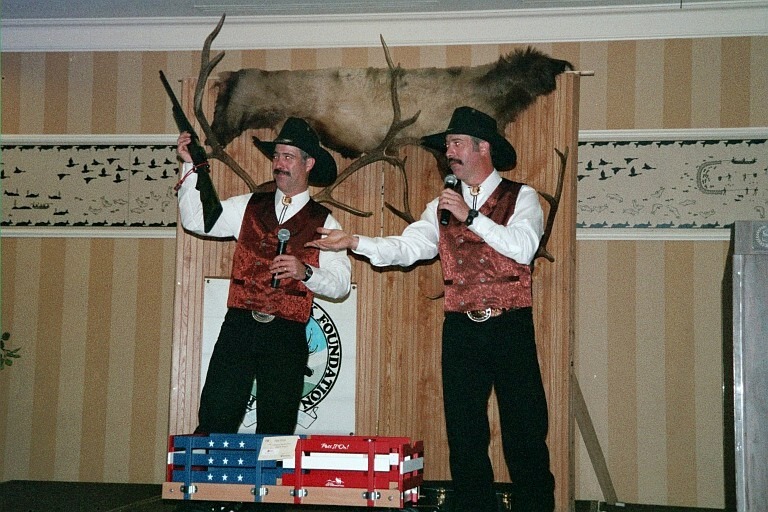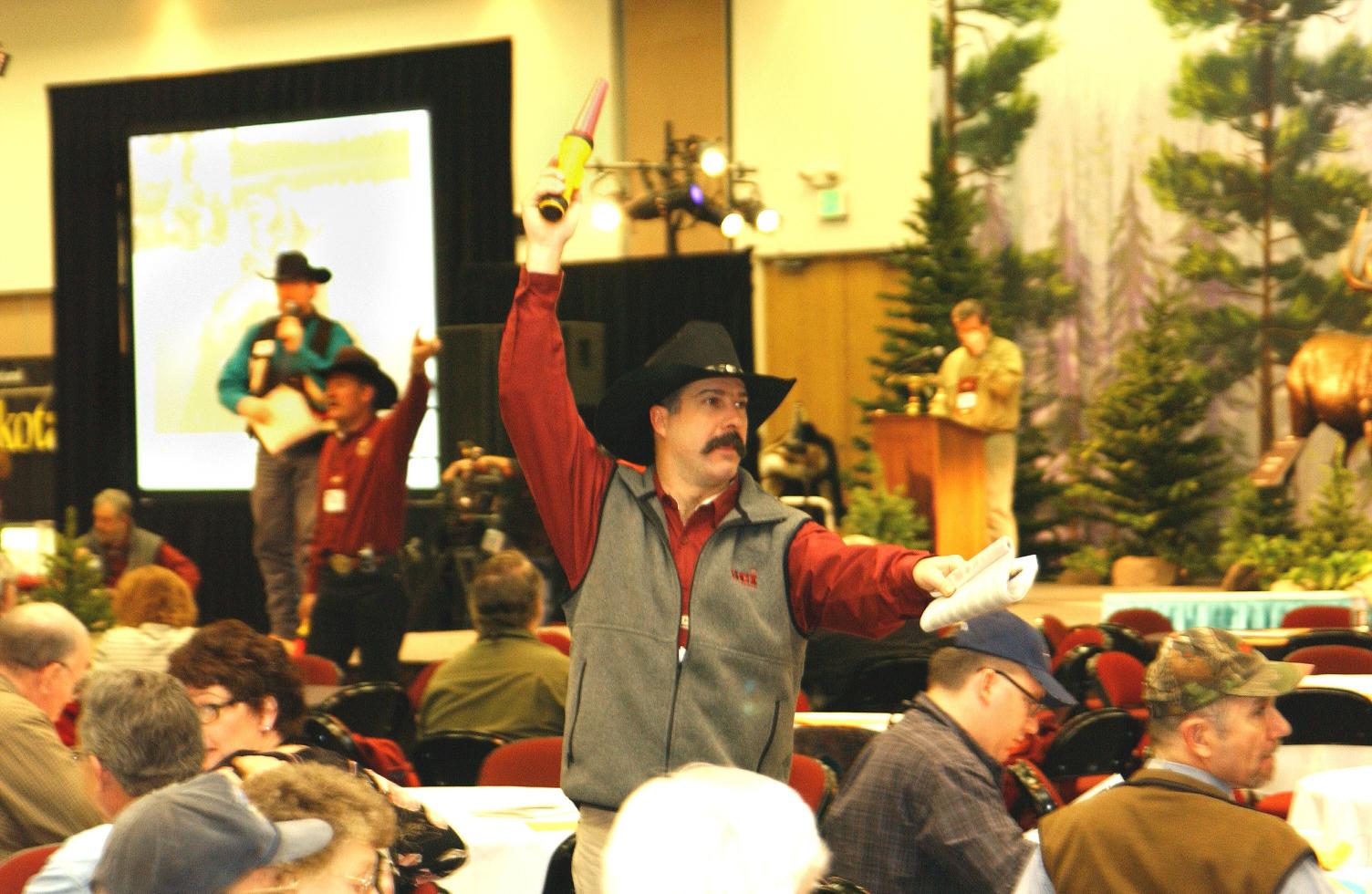|
|
There is no substitute for experience!
|
 |
|

Rohn & John Nelson - Auctioneers...
Open Buckle Auction Service
Benefit
Auction Planning:
• Using a corporate premium is a great way to encourage businesses to purchase
an entire table. For example, if a ten person table should sell for $375.00 ($25.00 per meal x 10, plus 1 membership per couple).
You might set the corporate table price at $600.00. As a premium, they get $200.00 in “auction Scrip”. This “scrip”
is credit to be used in the live auction. This scrip will help get people bidding, and when all is said and done, may not
even be used.
• Never provide the fair market value of auction items on tent cards or programs. Items sold
on the live auctions typically yield 75-100% of fair market value. Items sold on silent auctions typically yield 40-60% of
fair market value. The entire banquet net: gross ratio should be between 60-70%
• To set up your live auction
program, start by making a list of the 50 highest value items. Any that you don’t feel will sell well, move to the silent
auction or raffles. Use the highest value items in the live auction.The number of auction items should be equal to 10-12%
of the attendance Your live auction should contain a Maximum of 30 and 40 items. Smaller banquets (less than 300 people) set
a maximum of 25-30 items. Figure 2-3 minutes per item. Start your live auction so that it is concluded by 10:00 pm. Remember
90% of the items will be purchased by 10% of the crowd, and too many items will not increase the live auction income.
• When laying out the program, don’t put the highest value items at the end of the auction. People may
wait to bid on those items, not be successful, and leave with money they may have otherwise spent. Use a bell curve approach,
with your highest value items just past mid way through the auction (0.5-0.75 the way through). That way, unsuccessful bidders
on the high value items can bid on the lower value items later in the auction. Try to place a quality item every fifth item
in the program.
• A good audio system is absolutely necessary!! A surround-sound approach is best. A speaker
in each corner of the room will not blast out the people near the stage, and people in the back will be able to hear. Speaker
stands should be 9 feet tall so sound will not be in someone’s ear. Get three microphones, 1 for the auctioneer, 1 for
the MC, and an extra. Hotel sound systems are never as good as a rented system. If everyone can hear, it will increase his
or her enjoyment. A good sound system will rent for $150-$250, and it’s worth it.
• Use auction bid
cards with numbers that correlate to banquet ticket number. That way, the auctioneer can have a list of the bidders at the
stage, and can thank them by name. By having the bid/ticket number announced, the finance table can put the name and address
on the auction receipt before it goes to the bidder. An added bonus is that this bidder number can be used on the silent auction
and raffle tickets too, making it quick and easy to settle up with the cashier’s table at the end of your event.
• Be sure all restrictions or limitations of hunts, trips, getaways, special offers, etc. are fully understood
by both the auctioneer and the audience (How many people? How many days? If you bring a buddy? Trophy fees, transportation,
licenses, date/time, etc.). If they are printed in the program, you need not go through each restriction before you ask for
bids.
• If you have two identical items, keep one in reserve. The auctioneer can stop bidding when he gets
down to two bidders, and offer them both of the items at an identical price. Note: If items are offered “choice”
the second item must be purchased at the same price as the first, retained, or re-sold as a separate item. If the bidding
is not going well, keep the second item, and give it to your field director to use somewhere else.
• The first
three (3-4) items are live auction “pace setters.” They should be of medium value ($150-$200) and of quality enough
that anyone there would buy them if the price were right. This generates high, initial interest levels. It also establishes
your live auction as a “quality” merchandise auction. The auctioneer should sell these items as soon as the bidding
stops, and without warnings like “Going once....twice...” etc. This lets everyone know to bid quickly, and sets
the pace for the rest of the auction. If you don’t set the pace, they will wait until the last minute to bid for the
rest of the auction. Note: Late bids (after the auctioneer says “sold”) cannot be accepted.
•
Once the auction starts, never stop the auction!! The momentum is reduced to the beginning each time you stop the auction.
Do not draw door prizes, announce silent auction winners, draw raffles, hold calling or bugling contests etc. during the auction.
Bidding frenzies, or card raffles can be conducted just before the auction starts, to create excitement and give away a gun
to kick it off.
 |
|
|

FUNDRAISER AND BENEFIT AUCTION-IMPROVEMENT IDEAS
DURING
THE AUCTION:
• Conduct a sound check before you start! Make sure that everyone can hear and
understand what you are saying. The audience must be able to know what the item is, and what the bid is.
• Make
this one clear to the auctioneer: Don’t cut the opening bid! Start out at 30% of the Fair Market Value (FMV) and go up from
there. This way many of the items will sell above the FMV. Starting high and coming down tips off the audience to the “ceiling”
of the bid. Once the auctioneer sets a precedent of starting at FMV, then dropping the opening bid, he will in effect be asking
“Which sucker will bid at this price. If FMV is “Known” you will never exceed that amount.
• Make sure your caterer
doesn’t have any food on the table prior to dinner. You don’t want to give people any reason to sit down ahead of time. Chips,
dips, candy, Hors devours, pretzels, keep people from playing the games, raffles, silent auctions, and reviewing live auction
items.
• Start the auction during dinner. Fifteen to twenty minutes after the salads are served is good. This will
allow you to put another 10-15 items in your live auction where they will bring more money. If you’re serving dessert, serve
it at a specific time during the auction. For example, 10 minutes before a major auction item. Note: Some groups hold the
auction before dinner.
• Studies show that auction yields start to decline after 10:00 pm. Try to have the auction
over by then. You should sell an item every 2-3 minutes. Keep introductions brief, and don’t spend too much time explaining
things, which don’t matter. Most of the audience won’t be listening anyway. Continue to run the silent auction, raffles, and
games as long as possible.
• Make sure the item being sold is the only one being displayed. Auction guests like
to look up to the live auction stage and see a display which shows what the item, or number of the item, being auctioned is.
This way, the guests can visit with their friends but still keep track of the live auction.
• The high bid recorder
(Clerk) should be located at a small table next to the auction stage and should keep a cumulative total of the live auction
so the auctioneer may periodically announce to the guests the total raised as the auction proceeds. This also offers instant
clarification of price, bidder number, etc. if there is any confusion or interruptions.
• If you have a “unique”
item or a minimum bid item: i.e. and item by a local artist who is at your banquet, but you don’t think the item will sell
well, use this approach: Start the bid below the minimum, if the minimum is not reached, the auctioneer can announce that
the item won’t be sold for less than the minimum. Thank the artist, and go on to the next item. You haven’t made the artist
mad by selling at a low price, and you haven’t hurt the auction by setting a low precedent.
• Don’t allow anything
to sell to cheaply. The audience needs to understand that this is a fundraiser. Never tell the audience that they “got a good
deal on that one.” Only use phrases like “fabulous bidding” and “thank you for your generosity.” Avoid terms like “junk, stuff,
and things” instead only use words like “merchandise, donations, collectibles, valuables, items," etc.
• Always
keep in mind that the bidders are there to support your cause. They are not at the auction to go shopping. Show them a good
time and make them feel appreciated. They are entitled to go home with nothing but positive feelings about your event. THANK
YOU...THANK YOU...THANK YOU... should be said after every item is purchased including raffle items and silent auction items.
• Give
small tokens of appreciation out to the second bidder, such as key chains, hat pins, scarves, roses, mugs, caps etc. Every
single bid is IMPORTANT! The high bid should be applauded, but it won’t mean much without the other bids to get you there.
 |
|
|

John Nelson - SCI National Hunter Convention - Reno,
NV
• Bid Spotters and Ring Workers: YOU ARE THE KEY TO A SUCCESSFUL AUCTION... HIGH ENERGY = HIGH DOLLARS!
1. Divide
the room into sections (1/3 for 3 spotters, 1/4 for 4 spotters etc.). Each spotter should only accept bids from his designated
section. Keep your back to the auctioneer and FACE THE CROWD. Make it VERY obvious when you have a bid, by providing both
a VERBAL and VISUAL indication. Holler " YEAH!!! and KEEP YOUR HAND IN THE AIR... so long as you have the high bid. I am recommending
that each spotter have a traffic directing flash-light (with the illuminating cone). Turn on your light and hold it up while
you have the bid. This way, the bidders can easily tell if they are in or not, and there is no confusion between spotters.
The auctioneer should only have to accept bids from his spotters. This prevents the “wreck” of having two bidders (and spotters)
who both think they had the bid.
2. Identify the location of the top bidder so the runner may obtain the signature
of the bidder. The auctioneer will say “sold, price, and buyer” in that order. Tell the runner 1) who bought it, 2) where
they’re at and 3) what the price is. You also serve to identify bid locations for the audience.
3. Spotters can
cut the bid in half only when your bidder has refused to bid again. Establish a clear hand signal with the auctioneer before
hand to indicate a bid cut. Note: Don’t cut the bid prematurely. The auctioneer will generally cut the bid, and you offer
it to the bidder who is out.
4. Spotters must be enthusiastic. They should be very energetic, loud, and entertaining.
if the spotters are having a great time, the excitement will be catching to the audience. Auctions are lively! and exciting!
Be organized, be excited, be enthusiastic but most importantly: HAVE FUN, SMILE AT EVERYONE, THANK EACH BIDDER, and ENJOY
THE AUCTION.
|
|
|
 |
|